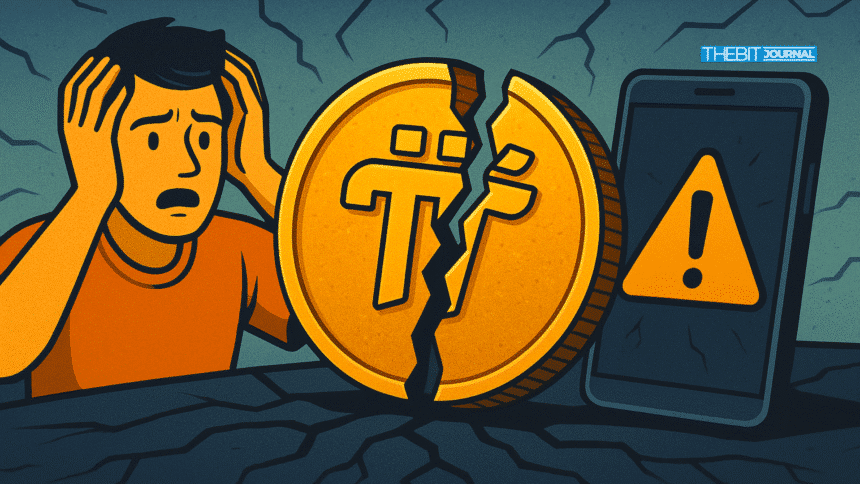Pi Network’s much-anticipated Mainnet migration, once hailed as the final bridge to user-owned crypto, is now facing intense backlash. Despite completing KYC verification, thousands of users report seeing zero Pi balances in their wallets. The delays have sparked community outrage, shaken token confidence, and placed the Pi Core Team under fire.
KYC Done, Coins Gone?
Despite passing the KYC process and following migration steps, many users report blank Pi balances. One user on X lamented:
“Give me back that damn Pi. I’ve worked hard for six years. You still haven’t mapped it. What’s the delay?”
Complaints are mounting on social media platforms like Reddit (#PiWalletFail), Twitter, and Facebook. Reports frequently note multiple wallet addresses under one account, yet none reflect migrated Pi coins. Community patience is wearing thin.
Price Takes a Hit Amid Crisis
Pi’s token price has reflected growing distrust. Following the widespread reports of missing balances:
Pi prices dropped by roughly 4%, hovering around $0.60–$0.63.
Crypto.news highlighted a 1.5% dip in one session, citing weak technical indicators like the RSI stuck around 40 .
IOU tokens reportedly fell 15% on some platforms.

Lack of token visibility and unclear migration statuses are creating a highly volatile environment.
Three‑Phase Plan, No Dates
The network’s official migration roadmap outlines a three-phase process:
Phase 1: Basic mining rewards, security circle rewards, node-based allocations, already deployed.
Phase 2: Referral bonuses and other incentives.
Phase 3: Ongoing periodic migrations (monthly/quarterly).
But crucially, no clear timeline or deadlines were provided. Analysts warn the lack of clarity is aggravating user mistrust.
Extended Deadlines, Shrinking Balances
Originally, the grace period for completing KYC and migration ended on March 14, 2025, at 08:00 UTC. Missing this date would forfeit most Pi, retaining only the previous six months’ worth. This tight deadline already fueled panic, and many struggled to meet requirements.
While some users did migrate, the second-phase rollout, including referral payouts, appears delayed indefinitely.
Community in Revolt
Long-time community leaders are making public demands for answers:
James Zito: “Pioneers deserve answers…we need clarity before Pi Day 2 on June 28”.
Dr. Altcoin echoed calls for fairness to loyal users.
The Pi Core Team has responded vaguely:
“We are aware of delays and are investigating.” .
But these statements have done little to console frustrated pioneers. Their cries range from accusations of a “scam” to warnings of dwindling trust.

Pi Network Technical Hurdles or Governance Issues?
Pi Network defends its slow approach, citing the complexity of migrating data from a six-year mobile mining history without introducing errors. Indeed, the migration process includes verifying activity, circle rewards, nodes, and bonuses.
Some delay patterns revolve around incomplete 2FA or email authentication issues. According to Crypto Times, users are sometimes unknowingly stuck because of missed verification steps, which force them to return to the app instead of migrating.
However, many affected users insist they completed every step, including 2FA months ago, and yet remain in limbo with stalled migration.
What Users Demand Now
The community is calling for:
A live migration dashboard, showing user statuses.
Time-bound Phase 2 rollout dates for referral and bonus migration.
Clear communication from Pi Team about progress and fixes.
Without these, pioneers fear the network will lose momentum, trust, and market relevance.
Can Pi Salvage Its Reputation?
Pi Network has built a massive community—reporting over 60 million registered users and 12 million migrated so far. Its grassroots, mobile-first appeal set it apart.
Recent developments, including wallet activation, KYC safeguards, and merchant integrations, showcased real-world potential. But glaring issues—wallet f**ckers, delayed bonus distributions, and ambiguous communication—threaten this momentum.
In today’s hyper-competitive crypto landscape, reputation erodes rapidly. If Pi resolves this swiftly, transparency, timelines, visible fixes—it can survive. But if delays drag on past June 28’s Pi Day 2, confidence could collapse.
Final Verdict
Pi Network’s Mainnet migration showed promise until execution faltered. The lack of token visibility, delayed referrals, and poor communication have triggered community revolt and price dips. To restore trust:
Pi must release a transactional dashboard,
Provide a fixed rollout calendar for Phase 2 bonuses.
Offer timely updates on system and support issues.
These strategic fixes are critical to cement Pi Network’s future as a credible, community-driven blockchain. Otherwise, this could go down in crypto lore as a case study in hype unraveling.
FAQs
Q: Why am I not seeing my Pi balance despite KYC?
A: Delays in migration—especially bonus phases—may cause your wallet to show zero temporarily.
Q: Has Pi lost popularity?
A: While still user-rich, its token (PI) has dropped ~4% and community trust is waning.
Q: What can Pi Core Team do now?
A: Launch a migration dashboard, announce rollout timelines, and provide regular status updates.
Glossary of Key Terms
KYC (Know Your Customer): A verification process to confirm user identity.
Mainnet Migration: The transfer of Pi coins from testnet to the live blockchain.
Referral Bonus: Rewards earned by inviting others to Pi Network.
Pi Day 2: A key milestone event for Pi Network, scheduled for June 28.
2FA (Two-Factor Authentication): An added security layer requiring a second form of verification.
Sources/References





























